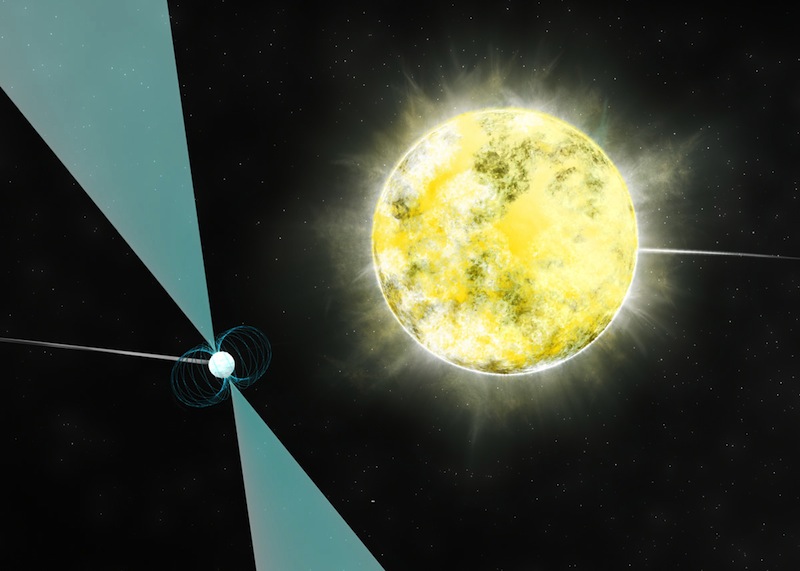Cold Dead Star May Be a Giant Diamond

Astronomers aren't being poetic when they say this star is a diamond.
Scientists have identified what is possibly the coldest white dwarf ever detected. In fact, this dim stellar corpse is so cold that its carbon has crystallized, effectively forming a diamond the size of Earth, astronomers said.
"It's a really remarkable object," study leader David Kaplan, a professor at the University of Wisconsin-Milwaukee, said in a statement from the National Radio Astronomy Observatory (NRAO). "These things should be out there, but because they are so dim they are very hard to find." [10 Strangest Things in Space]
Kaplan and colleagues were able to find this cosmic gem because it has a more conspicuous companion. The white dwarf does an orbital tango with a pulsar, or a fast-spinning neutron star formed from a supernova explosion that sends out a stream of radio waves like a lighthouse beam. Dubbed PSR J2222-0137, the pulsar lies 900 light-years away from Earth near the constellation Aquarius, and it was first detected using the NRAO's Green Bank Telescope in West Virginia.
Astronomers noticed that the radio signal from PSR J2222-0137 sometimes got delayed because a companion object was passing in front of it, warping space. Studying these delays using the NRAO's Very Large Baseline Array (VLBA) helped scientists determine that the pulsar has a mass 1.2 times that of Earth's sun with a companion that has a mass 1.05 times that of the sun.
The team suspected this companion was a white dwarf, or a dense stellar core left after a star has died. Believing they would be able to see the object in optical and infrared light, the scientists looked for it using the Southern Astrophysical Research (SOAR) telescope in Chile and the 10-meter (33 feet) Keck telescope in Hawaii. But neither instrument was able to detect the white dwarf.
"Because of the radio observations, we know exactly where to look, so we pointed SOAR there and collected light for two and a half hours," Bart Dunlap, a graduate student at the University of North Carolina at Chapel Hill, said in a statement. "Our final image should show us a companion 100 times fainter than any other white dwarf orbiting a neutron star and about 10 times fainter than any known white dwarf, but we don’t see a thing. If there's a white dwarf there, and there almost certainly is, it must be extremely cold."

When talking about stellar objects, "cold" is a relative term; this white dwarf is still burning at 4,892 degrees Fahrenheit (2,700 degrees Celsius), but that's 5,000 times cooler than the center of Earth's sun.
Such a cool object would be largely crystallized carbon, similar to a diamond, the scientists said. Astronomers have theorized that these objects should be lurking in the universe, but diamond stars are difficult to detect because they are so faint.
Get the Space.com Newsletter
Breaking space news, the latest updates on rocket launches, skywatching events and more!
Scientists have theorized that diamond alien planets should exist, too. A "super-Earth" 40 light-years from our planet called 55 Cancri e is suspected to be one such world; a 2012 paper in the Astrophysical Journal Letters argued that this exoplanet is composed mainly of carbon in the form of diamond and graphite.
The study on the diamond white dwarf was published in the Astrophysical Journal.
Follow Megan Gannon on Twitter and Google+. Follow us @Spacedotcom, Facebook or Google+. Originally published on Space.com.
Join our Space Forums to keep talking space on the latest missions, night sky and more! And if you have a news tip, correction or comment, let us know at: community@space.com.

Megan has been writing for Live Science and Space.com since 2012. Her interests range from archaeology to space exploration, and she has a bachelor's degree in English and art history from New York University. Megan spent two years as a reporter on the national desk at NewsCore. She has watched dinosaur auctions, witnessed rocket launches, licked ancient pottery sherds in Cyprus and flown in zero gravity on a Zero Gravity Corp. to follow students sparking weightless fires for science. Follow her on Twitter for her latest project.









